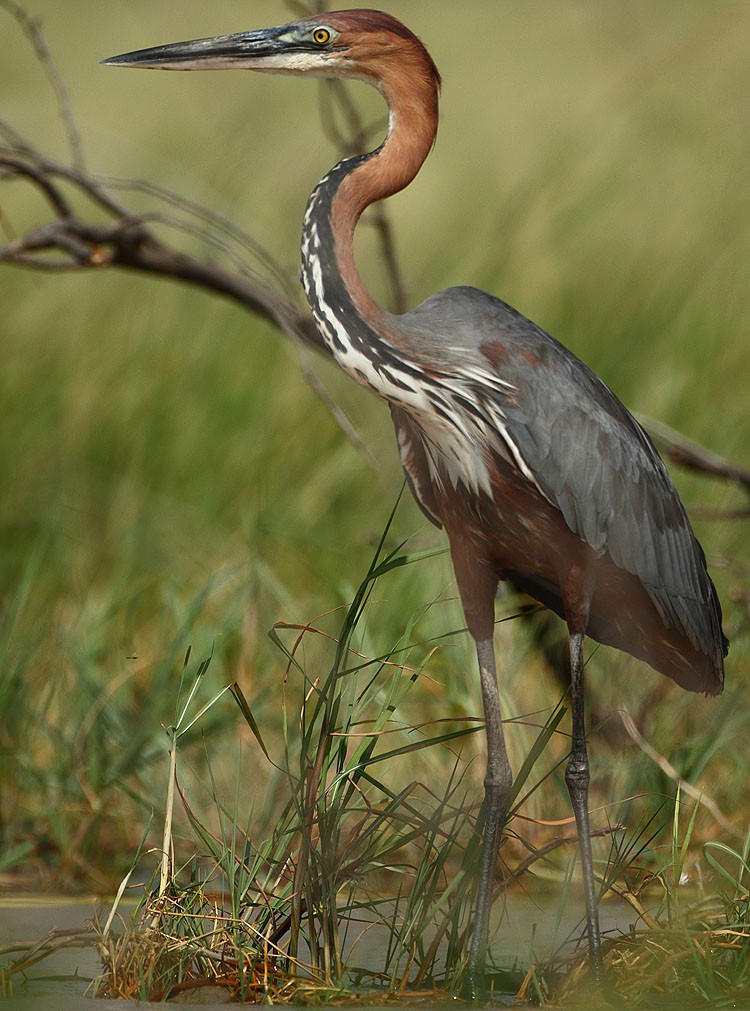Goliath Heron
A species of Great herons Scientific name : Ardea goliath Genus : Great herons
Goliath Heron, A species of Great herons
Botanical name: Ardea goliath
Genus: Great herons
Content
Description General Info
 Photo By Steve Garvie , used under CC-BY-SA-2.0 /Cropped and compressed from original
Photo By Steve Garvie , used under CC-BY-SA-2.0 /Cropped and compressed from original Description
This is the world's largest living heron (the extinct Bennu heron was larger). The height of the goliath heron is 120–152 cm (3 ft 11 in–5 ft 0 in), the wingspan is 185–230 cm (6 ft 1 in–7 ft 7 in) and the weight is 4–5 kg (8.8–11.0 lb). Among standard measurements, the tarsus measures from 21.2 to 25.5 cm (8.3 to 10.0 in) and the wing chord averages around 60.7 cm (23.9 in) in length. The culmen measures from 18 to 20 cm (7.1 to 7.9 in), while the bill from the gape measures around 24 cm (9.4 in). In flight it has a slow and rather ponderous look and, unlike some other herons, its legs are not held horizontally. Male and female look similar, with an overall covering of slate gray and chestnut feathers. The head and its bushy crest, face, back and sides of the neck are chestnut. The chin, throat, foreneck and upper breast are white, with black streaks across the foreneck and upper breast. The lower breast and belly are buff with black streaks. The back and upper wings are slate-grey, with a chestnut shoulder patch at the bend of the wings when they're closed. The under-wing is pale chestnut. The upper mandible is black and the lores and orbital areas are yellow with a greenish tinge. The eyes are yellow while legs and feet are black. Juveniles look similar to the adults, but are paler. The only heron with somewhat similarly-colorful plumage characteristics, the widespread purple heron, is much smaller than the Goliath. Despite the shared plumage characteristics with the purple species, the closest extant relatives of the Goliath are considered to be the great-billed and the white-bellied herons of Southern Asia. Due to their large size, this species trio is sometimes referred to as the "giant herons". The Goliath heron has a distinct deep bark, often described as kowoork, audible from a distances of up to 2 km. A disturbance call (arrk), sharper and higher, can also occasionally be heard. A huh-huh is given during the crouched stage, while a krooo may be heard with the neck extended. Organ-like duetting has been reported at nest sites but has not been confirmed. 
Size
1.4 m
Life Expectancy
22 years
Nest Placement
Ground
Feeding Habits
Goliath Heron are diurnal, solitary foragers, preferring large fish like breams and mullet, averaging 500-600g. They hunt by still-watching in shallow waters or from floating vegetation, spearing prey with a rapid bill thrust, and are prone to kleptoparasitism during their long handling time.
Habitat
Goliath Heron primarily occupies aquatic habitats, thriving in freshwater environments such as lakes, swamps, and rivers, and is also found in coastal areas like mangrove wetlands and reefs. These habitats can range from sea-level to elevations of up to 2,100 m (6,900 ft). Goliath Heron shows a preference for shallow water near lakeshores but can adapt to various aquatic settings, including deep waters with dense aquatic vegetation and even small watering holes. Its presence is usually confined to undisturbed wetlands, as it tends to avoid areas frequently impacted by human activity.
Dite type
Piscivorous
General Info
Feeding Habits
Bird food type
Behavior
Goliath herons are solitary foragers and are highly territorial towards other Goliaths entering their feeding territories. On occasions, two may be seen together but these are most likely to be a breeding pair or immatures. A diurnal and often rather inactive feeder, this heron often hunts by standing in the shallows, intently watching the water at its feet. This is a typical feeding method among large Ardea herons and it can forage in deeper waters than most due to its larger size. It may also perch on heavy floating vegetation, in order to prevent water from rippling around them. As prey appears, the heron rapidly spears it with open mandibles, often spearing both mandibles through the fish's body, and then swallows it whole. It is possible that the bill is used in a lure-like fashion occasionally, attracting fish to the immobile, large object submerged in the water. The handling period is long, with herons often placing their struggling prey on floating vegetation while preparing to swallow it. Due to its generally slow movements and handling time, the Goliath is frequently vulnerable to kleptoparasitism. In Africa, African fish eagles frequently pirate food caught by Goliaths, although other large birds such as saddle-billed storks and pelicans may also steal their prey. Prey almost entirely consists of fish. The Goliath heron specializes in relatively large fish, with an average prey weight range in Natal of 500–600 g (1.1–1.3 lb) and length of 30 cm (12 in). Exceptionally, the largest fish targeted may measure 50 cm (20 in) although the heron may not be able to swallow prey up to this size. Small fish are generally ignored and the average Goliath catches around 2 or 3 fish a day. Breams, mullet, tilapia and carp have locally been recorded as preferred species. Any other small animals that they come across may be eaten, including frogs, prawns, small mammals, lizards, snakes, insects and even carrion. 
Species Status
Not globally threatened.
Scientific Classification
Phylum
Chordates Class
Birds Order
Pelicans and Relatives Family
Herons Genus
Great herons Species
Goliath Heron